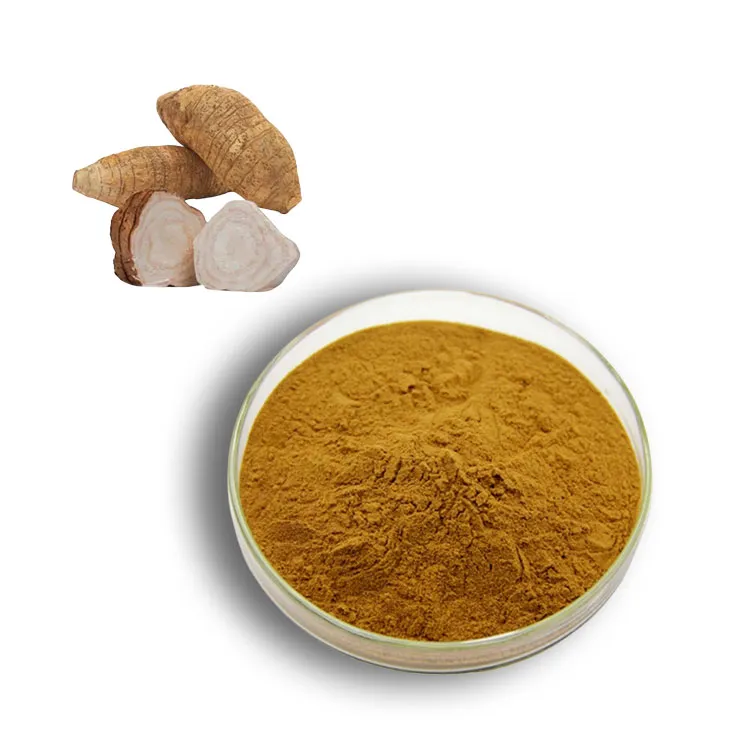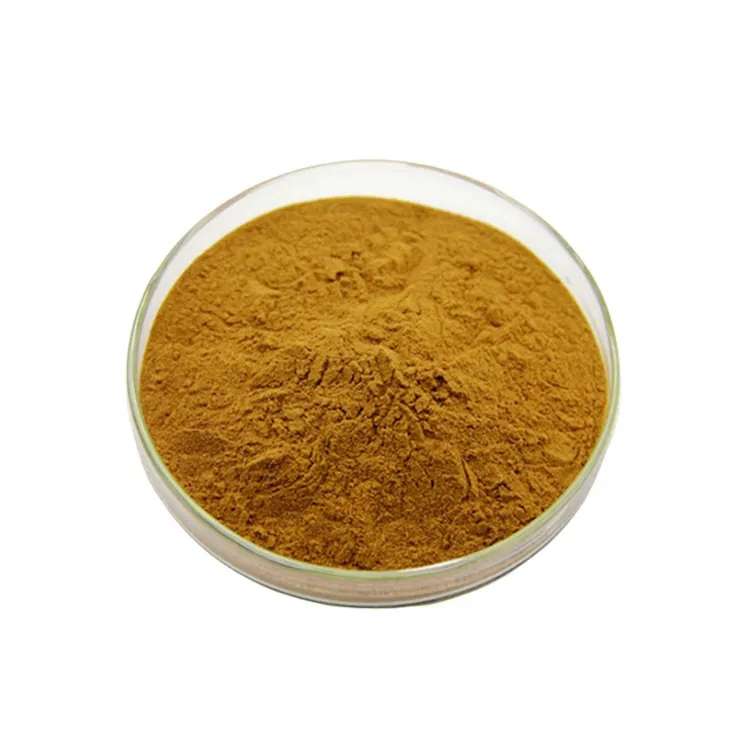- 0086-571-85302990
- sales@greenskybio.com
Optimal Bioavailability of Pueraria lobata Extract.
2024-11-28

1. Introduction
Pueraria lobata, also known as kudzu, has been used in traditional medicine for centuries. The extract of Pueraria lobata contains a variety of bioactive compounds, such as isoflavones, which have been associated with numerous health benefits, including anti - inflammatory, antioxidant, and estrogen - like activities. However, the bioavailability of these compounds from the extract can be highly variable, depending on several factors. Understanding how to optimize the bioavailability of Pueraria Lobata Extract is crucial for maximizing its potential health - promoting effects.

2. Chemical Composition of Pueraria Lobata Extract
2.1 Isoflavones
- Isoflavones are the major bioactive components in Pueraria Lobata Extract. Daidzein, Genistein, and puerarin are among the most abundant isoflavones present. These compounds have a structure similar to that of estrogen, which allows them to interact with estrogen receptors in the body.
- The chemical structure of isoflavones also affects their solubility and absorption. For example, the presence of glycosidic linkages in some isoflavones can reduce their absorption compared to their aglycone forms. Puerarin, which is a glycoside - bound isoflavone, may require enzymatic hydrolysis in the gut to be effectively absorbed.
2.2 Other Compounds
- In addition to isoflavones, Pueraria lobata extract contains flavonoids, such as Quercetin and kaempferol. These flavonoids can also contribute to the overall antioxidant and anti - inflammatory properties of the extract.
- There are also polysaccharides in the extract. These polysaccharides may play a role in modulating the immune system, although their impact on bioavailability is less well - understood compared to isoflavones.

3. Impact of Delivery Systems on Bioavailability
3.1 Oral Delivery
- When Pueraria lobata extract is taken orally, it must pass through the digestive system. The acidic environment of the stomach and the enzymatic activities in the gut can both affect the stability and bioavailability of the extract's components.
- Formulating the extract into different oral dosage forms, such as tablets, capsules, or liquid suspensions, can influence its bioavailability. For example, enteric - coated tablets can protect the extract from the acidic environment of the stomach, allowing for better release and absorption in the intestines.
3.2 Nanoparticle - based Delivery
- Nanoparticle - based delivery systems have shown great potential for improving the bioavailability of Pueraria lobata extract. Nanoparticles can be designed to encapsulate the bioactive compounds, protecting them from degradation and enhancing their solubility.
- These nanoparticles can also target specific cells or tissues in the body, increasing the efficiency of drug delivery. For example, nanoparticles coated with ligands that can bind to receptors on intestinal epithelial cells may facilitate the uptake of the encapsulated Pueraria lobata extract components.
3.3 Lipid - based Delivery
- Lipid - based delivery systems, such as lipid emulsions or liposomes, can improve the bioavailability of hydrophobic components in Pueraria lobata extract. Lipids can increase the solubility of these compounds, making them more accessible for absorption.
- Liposomes, in particular, can mimic the cell membrane structure, which may enhance the interaction between the extract components and the intestinal cells, leading to improved uptake.

4. Role of Gut Microbiota in Bioavailability
4.1 Metabolism by Gut Microbiota
- The gut microbiota plays a crucial role in the metabolism of Pueraria lobata extract components. Some isoflavones, such as daidzein, can be metabolized by gut bacteria into more bioactive forms. For example, daidzein can be converted into equol, which has a higher estrogen - like activity than daidzein itself.
- The composition of the gut microbiota can vary among individuals, which may lead to differences in the metabolism and bioavailability of Pueraria lobata extract. Factors such as diet, lifestyle, and antibiotic use can all influence the gut microbiota composition.
4.2 Interaction between Gut Microbiota and Delivery Systems
- Some delivery systems may also interact with the gut microbiota. For example, nanoparticle - based delivery systems may affect the growth and activity of gut bacteria. Understanding these interactions is important for developing delivery systems that can optimize the bioavailability of Pueraria lobata extract in the context of the gut microbiota.
- Lipid - based delivery systems may also be influenced by the gut microbiota. The digestion and absorption of lipids can be modulated by gut bacteria, which in turn can affect the release and bioavailability of the Pueraria lobata extract components encapsulated in lipid - based carriers.
5. Strategies for Optimizing Bioavailability
5.1 Pre - treatment of Extract
- Pre - treating the Pueraria lobata extract to convert glycosidic - bound isoflavones into their aglycone forms can improve absorption. This can be achieved through enzymatic hydrolysis or other chemical methods.
- Removing impurities or inactive components from the extract may also enhance its bioavailability by reducing interference with the absorption of bioactive compounds.
5.2 Combination with Bioavailability - Enhancing Agents
- Combining Pueraria lobata extract with bioavailability - enhancing agents can be an effective strategy. For example, co - administration with certain vitamins or minerals may improve the absorption of isoflavones. Vitamin C has been shown to enhance the antioxidant activity of Pueraria lobata extract, which may also indirectly improve its bioavailability.
- Some natural compounds, such as piperine from black pepper, can inhibit drug - metabolizing enzymes in the gut, thereby increasing the bioavailability of co - administered drugs or natural extracts. Incorporating such compounds with Pueraria lobata extract may be a promising approach.
5.3 Personalized Approaches
-
5.3.1 Based on Gut Microbiota Profile
- Given the role of gut microbiota in bioavailability, personalized approaches based on an individual's gut microbiota profile may be developed. For example, if an individual has a gut microbiota that is less efficient in metabolizing isoflavones, supplementation with specific probiotics to modify the gut microbiota composition may be considered to improve the bioavailability of Pueraria lobata extract.
- Using metagenomic analysis to understand an individual's gut microbiota function and then tailoring the delivery system or pre - treatment method of the Pueraria lobata extract accordingly could be a future direction in optimizing bioavailability. 5.3.2 Based on Genetic Factors
- Genetic factors can also influence the bioavailability of Pueraria lobata extract. Some individuals may have genetic polymorphisms in genes related to drug metabolism or absorption, which can affect how their bodies process the extract's components. Identifying these genetic factors and developing personalized strategies based on them could improve the effectiveness of Pueraria lobata extract utilization.
6. Conclusion
Optimizing the bioavailability of Pueraria lobata extract is a complex but important area of research. By understanding the chemical composition of the extract, the impact of delivery systems, and the role of gut microbiota, as well as implementing strategies such as pre - treatment, combination with enhancing agents, and personalized approaches, it is possible to maximize the potential health - promoting effects of Pueraria lobata extract. Continued research in this area will not only benefit the development of Pueraria lobata - based products but also contribute to the broader field of natural product utilization and human health.
FAQ:
Question 1: What is the importance of studying the optimal bioavailability of Pueraria lobata extract?
The study of optimal bioavailability of Pueraria lobata extract is important because it helps in maximizing the potential health benefits. By understanding how to achieve the best bioavailability, we can ensure that the active components in the extract are effectively absorbed and utilized by the body. This is crucial for those interested in using Pueraria lobata extract for its various health - promoting effects, such as antioxidant, anti - inflammatory, and hormonal regulation properties.
Question 2: How does the chemical composition of Pueraria lobata extract affect its bioavailability?
The chemical composition of Pueraria lobata extract plays a significant role in its bioavailability. Compounds such as isoflavones, flavonoids, and saponins present in the extract can have different solubilities, stabilities, and interactions with the body's physiological environment. For example, some components may be poorly soluble in water, which can limit their absorption. Understanding these chemical properties helps in formulating strategies to enhance bioavailability, like using appropriate solvents or modifying the chemical structure of the active compounds.
Question 3: What are the different delivery systems considered for improving the bioavailability of Pueraria lobata extract?
Different delivery systems can be considered for improving the bioavailability of Pueraria lobata extract. Nanoparticle - based delivery systems are one option. They can protect the active components from degradation in the gastrointestinal tract and enhance their absorption across the intestinal barrier. Liposomal delivery systems are also being explored. These can encapsulate the extract components and improve their solubility and cellular uptake. Additionally, polymeric micelles can be used to increase the bioavailability by improving the stability and solubility of the extract's active ingredients.
Question 4: How does the gut microbiota interact with Pueraria lobata extract to influence its bioavailability?
The gut microbiota can interact with Pueraria lobata extract in multiple ways to influence its bioavailability. Some gut bacteria can metabolize the components of the extract, converting them into more bioactive or more easily absorbable forms. For example, they may break down complex isoflavones into simpler metabolites that can be more readily absorbed by the intestinal cells. On the other hand, the composition of the gut microbiota can also affect the integrity of the intestinal barrier, which in turn can impact the absorption of the extract components.
Question 5: What are the potential applications of achieving optimal bioavailability of Pueraria lobata extract?
Once optimal bioavailability of Pueraria lobata extract is achieved, there are several potential applications. In the field of medicine, it can be used more effectively for the treatment or prevention of various diseases, such as menopausal symptoms, osteoporosis, and cardiovascular diseases. In the cosmetic industry, it can be incorporated into products to take advantage of its antioxidant and anti - aging properties. Additionally, in the food and nutraceutical industries, it can be formulated into products to provide consumers with its health - promoting benefits more efficiently.
Related literature
- Bioavailability and Metabolism of Pueraria lobata Isoflavones"
- "Enhancing the Bioactivity of Pueraria lobata Extract through Delivery System Optimization"
- "The Role of Gut Microbiota in the Absorption of Pueraria lobata Compounds"
- ▶ Hesperidin
- ▶ citrus bioflavonoids
- ▶ plant extract
- ▶ lycopene
- ▶ Diosmin
- ▶ Grape seed extract
- ▶ Sea buckthorn Juice Powder
- ▶ Beetroot powder
- ▶ Hops Extract
- ▶ Artichoke Extract
- ▶ Reishi mushroom extract
- ▶ Astaxanthin
- ▶ Green Tea Extract
- ▶ Curcumin Extract
- ▶ Horse Chestnut Extract
- ▶ Other Problems
- ▶ Boswellia Serrata Extract
- ▶ Resveratrol Extract
- ▶ Marigold Extract
- ▶ Grape Leaf Extract
- ▶ blog3
- ▶ blog4
-
Chinese Hawthorn Extract Powder Suppliers.
2024-11-28
-
The best Tongkat Ali extract in nature.
2024-11-28
-
Chinese Ginger Extract Powder Suppliers.
2024-11-28
-
Organic non - transgenic black rice extract.
2024-11-28
-
Motherwort Extract
2024-11-28
-
Tongkat Ali Extract Powder
2024-11-28
-
Horse Chestnut Extract
2024-11-28
-
Licorice Root Extract Powder
2024-11-28
-
Sea buckthorn oil
2024-11-28
-
Elderberry Extract
2024-11-28
-
Scutellaria Extract
2024-11-28
-
Saw Palmetto Extract
2024-11-28
-
Beta Carotene
2024-11-28
-
Citrus Aurantii Extract
2024-11-28





















